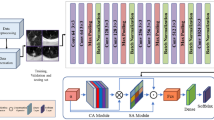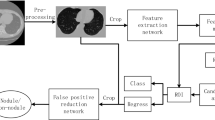Abstract
This paper proposed models based on CNN to detect lung cancer tumors in CT images. More details, three models combined multiple Convolutional Attention Networks were generated: (1) ATT (Attention-Triplet-Triplet) used triple loss in training and testing; (2) ASS (Attention–Softmax–Softmax) used Softmax loss in training and testing; (3) AST (Attention–Softmax–Triplet), AST (Attention-Softmax–Triplet) used ASS as a pre-trained model in training and triplet loss in testing. Theoretical and empirical analyses were discussed to demonstrate the efficacy of the AST model in comparison with ATT and ASS. The feasibility of the AST model is also confirmed when compared to other methods on the same dataset (AST obtained has a specificity of 98.9%).
Access this chapter
Tax calculation will be finalised at checkout
Purchases are for personal use only
Similar content being viewed by others
References
Lung Cancer Statistic Homepage. https://www.wcrf.org/dietandcancer/cancer-trends/lung-cancer-statistics. Accessed 15 Oct 2019
Ignatious, S., Joseph, R.: Computer aided lung cancer detection system. In: Global Conference on Communication Technologies (GCCT), Thuckalay, pp. 555–558 (2015)
Setio, A.A.A., et al.: Pulmonary nodule detection in CT images: false positive reduction using multi-view convolutional networks. IEEE Trans. Med. Imaging 35(5), 1160–1169 (2016)
Ding, J., Li, A., Hu, Z., Wang, L.: Accurate pulmonary nodule detection in computed tomography images using deep convolutional neural networks. In: Descoteaux, M., Maier-Hein, L., Franz, A., Jannin, P., Collins, D.Louis, Duchesne, S. (eds.) MICCAI 2017. LNCS, vol. 10435, pp. 559–567. Springer, Cham (2017). https://doi.org/10.1007/978-3-319-66179-7_64
GitHub Swethasubramanian Page. https://git.io/Jf9Og. Accessed 15 Aug 2019
Hu, J., Shen, L., Albanie, S., Sun, G., Wu, E.: Squeeze-and-excitation networks. In: The IEEE Conference on Computer Vision and Pattern Recognition (CVPR), pp. 7132–7141 (2018)
He, K., Zhang, X., Ren, S., Sun, J.: Deep residual learning for image recognition. In: IEEE Conference on Computer Vision and Pattern Recognition (CVPR), Las Vegas, NV, pp. 770–778 (2016)
Schroff, F., Kalenichenko, D., Philbin, J.: FaceNet: a unified embedding for face recognition and clustering. In: IEEE Conference on Computer Vision and Pattern Recognition (CVPR), Boston, MA, pp. 815–823 (2015)
Elfadel, I.M., Wyatt Jr, J.L.: The softmax nonlinearity: derivation using statistical mechanics and useful properties as a multiterminal analog circuit element. In: Cowan, J., Tesauro, G., Giles, C.L. (eds.) Advances in Neural Information Processing Systems, vol. 6, pp. 882–887. Morgan Kaufmann, San Mateo (1994)
LIDC-IDRI Homepage. https://wiki.cancerimagingarchive.net/display/Public/LIDC-IDRI. Accessed 10 May 2019
LuNa Homepage. https://luna16.grand-challenge.org/. Accessed 20 Sep 2019
Kingma, D.P., Ba, L.J.: Adam: a method for stochastic optimization. In: International Conference on Learning Representations (ICLR), 13 p. (2015)
Branco, P., Torgo, L., Ribeiro, R.: A survey of predictive modeling on imbalanced domains. ACM Comput. Surv. 49(2), 1–50 (2016). Article 31
Li, X., Wang, W.: Learning discriminative features via weights-biased softmax loss (2019). arXiv preprint arXiv:1904.11138. Accessed 12 Feb 2020
Acknowledgements
This research is funded by Saigon University under grant number CS2018-58.
Author information
Authors and Affiliations
Corresponding author
Editor information
Editors and Affiliations
Rights and permissions
Copyright information
© 2020 ICST Institute for Computer Sciences, Social Informatics and Telecommunications Engineering
About this paper
Cite this paper
Lai, K.D., Cao, T.M., Thai, N.H., Le, T.H. (2020). The Combination of Attention Sub-convnet and Triplet Loss for Pulmonary Nodule Detection in CT Images. In: Miraz, M.H., Excell, P.S., Ware, A., Soomro, S., Ali, M. (eds) Emerging Technologies in Computing. iCETiC 2020. Lecture Notes of the Institute for Computer Sciences, Social Informatics and Telecommunications Engineering, vol 332. Springer, Cham. https://doi.org/10.1007/978-3-030-60036-5_16
Download citation
DOI: https://doi.org/10.1007/978-3-030-60036-5_16
Published:
Publisher Name: Springer, Cham
Print ISBN: 978-3-030-60035-8
Online ISBN: 978-3-030-60036-5
eBook Packages: Computer ScienceComputer Science (R0)




